AMD Radeon HD 7990 Review: 7990 Gets Official
by Ryan Smith on April 24, 2013 12:01 AM EST- Posted in
- GPUs
- AMD
- Radeon
- Radeon HD 7000
- Tahiti
Sleeping Dogs
Another Square Enix game, Sleeping Dogs is one of the few open world games to be released with any kind of benchmark, giving us a unique opportunity to benchmark an open world game. Like most console ports, Sleeping Dogs’ base assets are not extremely demanding, but it makes up for it with its interesting anti-aliasing implementation, a mix of FXAA and SSAA that at its highest settings does an impeccable job of removing jaggies. However by effectively rendering the game world multiple times over, it can also require a very powerful video card to drive these high AA modes.
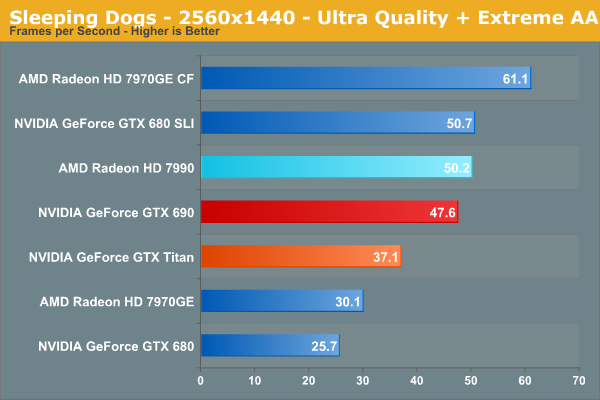
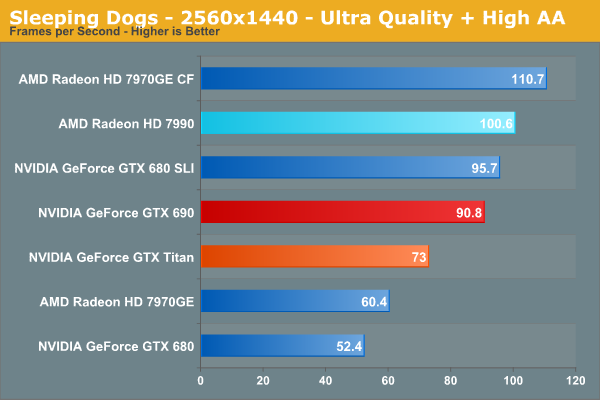
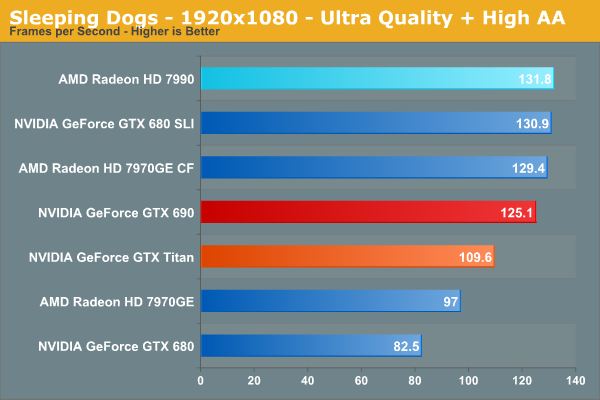
Sleeping Dogs is one of the games targeted by NVIDIA’s latest driver update, and as a result the performance gap between AMD and NVIDIA setups has narrowed since when we first started using it. Ultimately this is still a game that AMD does better at, and the 7990 is always ahead of the GTX 690 by at least a few frames per second, never mind the much greater lead over Titan. We generally value single-GPU cards for their consistency, but in times like these Titan pays heavily for it compared to the likes of the 7990.
Meanwhile at 5760 we’re once again seeing the 7990 trail the 7970GE CF by quite a large degree; the gap is now 18%. So at the highest and most demanding settings there is still a clear performance advantage for two-card CrossFire setups, as we’re seeing here.
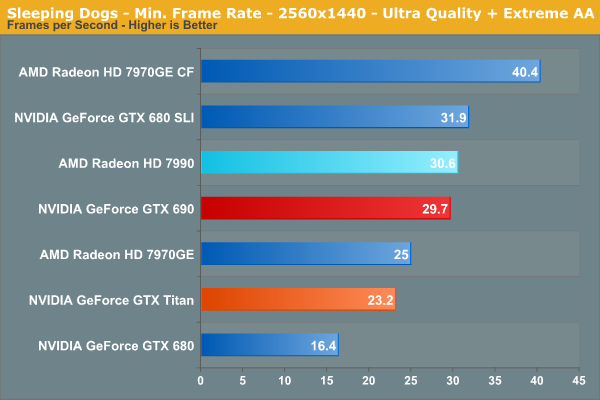
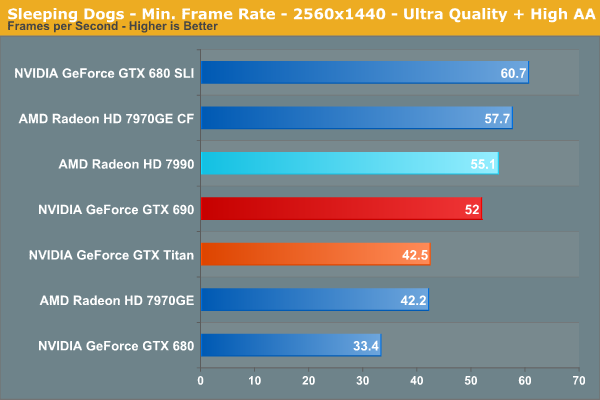
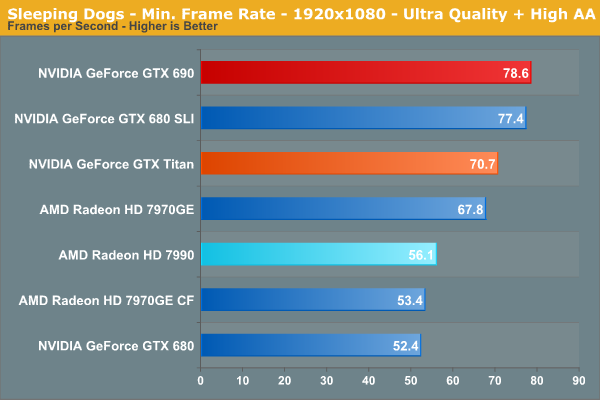
Something about Sleeping Dogs at lower resolutions holds back AMD CF setups, which means the 7990 gets impacted here too. 55fps is reasonable enough for playability purposes, but this is a good example of why multi-GPU scaling isn’t an infallible solution.










91 Comments
View All Comments
colonelclaw - Wednesday, April 24, 2013 - link
The card I don't understand the price/performance/name of is the Titan. Looking at these charts shouldn't Nvidia have called it the GTX780? Maybe I'm reading it wrong, but it doesn't look like much more than the standard generational change we normally get once a year from Nvidia/AMD, and follows on from 2012's 6xx series. Charging a grand for it seems a little offensive, in my opinion.prime2515103 - Wednesday, April 24, 2013 - link
"The GTX 690 is a 300W card and the 7990 is a 375W card. The GTX 690 consumes around 75W less power and puts off 75W less heat, full stop."If the 690 was consuming 75W less power and dissipating 75W less heat, it would be drawing 150W less in total. How did you calculate this?
tk11 - Wednesday, April 24, 2013 - link
Consumed power = dissipated heat. He's just pointing out that the increased power draw also equates to an increase of 75W of heat output.sulu1977 - Wednesday, April 24, 2013 - link
3 fans? Oh please, you can do better than that. For that price I want at least 9 whizzing fans because I simply love my quiet workroom to sound like a busy airport.tk11 - Wednesday, April 24, 2013 - link
More fans != more noise because more fans running at lower speeds make less noise than fewer fans running at higher speeds.chadwilson - Wednesday, April 24, 2013 - link
I know the whole mindset of put it out on release, but I really don't see a reason to read this article without FCAT information. Anyone who would be considering a purchase will be waiting until this data comes available with the latest drivers, so the entire article IMO is moot without it.JarredWalton - Wednesday, April 24, 2013 - link
Personally, if you're concerned about FCAT I think you'll want to wait about three months before buying any dual-GPU AMD setup. Maybe they'll surprise me and fix their drivers before then, but I'm betting on partial and flaky fixes for a little while longer.Beavermatic - Wednesday, April 24, 2013 - link
looks like Nvidia already responded with a Titan Ultra model today...http://www.cinemablend.com/games/Nvidia-Teases-GTX...
seeing how the 7990 is a dual-gpu card, and the Titan is a single GPU, I would hope the 7990 would beat it. You'd have been a lot wiser to compare it to Nvidia's dual GPU card, the 690 (which is already faster than the Titan to begin with).
The fact remains, the titan is like 15 to 20% slower than the 690 or 7990, and its single GPU. That's pretty damn impressive that the single-gpu titan can compete with the dual-gpu cards. Toss in another titan for SLI, and it slaughters both of those cards, lolololol. And not by a small amount, but by leaps and bounds.
Also, check the 7990 benchmarks, look at the microstutter and framerate averages. They are god awfully terrible as well as power consumption. What good is a card when it's rollercoastering framerates like mad? I know Nvidia's SLI has some issues as well, but they've really fined tuned it, but AMD's crossfire and multigpu cards are just horrendous, and shouldn't even be considered.
Nfarce - Wednesday, April 24, 2013 - link
"The fact remains, the titan is like 15 to 20% slower than the 690 or 7990, and its single GPU. That's pretty damn impressive that the single-gpu titan can compete with the dual-gpu cards. Toss in another titan for SLI, and it slaughters both of those cards, lolololol. And not by a small amount, but by leaps and bounds."Yeah, and you would be "leaps and bounds" $2000 lighter in the bank account too (or in credit card debt like the way many home PC builders pay for the components in their rigs). You can bet $2k in price would not equal double performance what $1k could buy.
Beavermatic - Wednesday, April 24, 2013 - link
I've got (2) Titan's in SLI and I didn't use a credit card, just sayn'